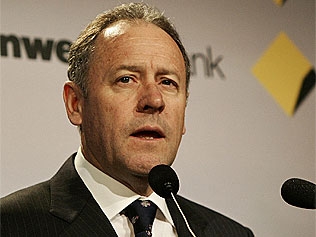
Commonwealth Bank of Australia Chief Executive and former ASB Chief Executive Ralph Norris has revealed that Australasia's big four banks had been stress tested with the assumption that house prices fell signficantly and had passed the tests.
Some international observers have warned that Australian and New Zealand house prices are vulnerable to big falls, which would pressure the big four banks (NAB-BNZ, CBA-ASB, ANZ-National and Westpac).
However, Norris told Andrew Patterson at Radio Live in New Zealand that growth in bank lending and bank profits on both sides of the Tasman would be only moderate in coming years because of higher funding costs and a lack of easy funding from international markets.
"I'm not so concerned about house price isssues being an impact on the banking industry," said Norris, who runs Australia's biggest home mortgage lender.
"We've done some pretty harsh scenarios looking at significant house price drops," he said.
"From the point of view of what that does to the banking system, while it's not a thing you'd wish to happen, it doesn't mean that banks in Austrlaia and New Zealand would fail. All of the banks internationally have been going through stress testing and certainly banks in Australia and NZ have been stress tested, and those stress tests show that the industry holds up very well." he said.
"In Australasia, we've come through this very very well. Australian and NZ banks didn't suffer."
Norris was speaking in a pre-recorded interview last week before CBA's annual results due to be published today in Australia.
Funding costs high
Norris said funding costs were now significantly higher than before the Global Financial Crisis and he expected further financial market and funding volatility.
"If I look at the issues that effect New Zealand and Australian banks, it really comes down to funding," he said, noting both Australia and New Zealand ran significant current account deficits and therefore needed foreign funding to continue growing credit.
"There were times when markets froze particularly around the time of the Lehman failure. Over recent months with the sovereign debt crisis, we haven't seen markets freeze, but the cost of money has gone up," he said.
"We take a view that growth is going to be a lot more moderate over the next couple of years and therefore we don't see that credit growth will be as strong, and we don't expect as significant requirement for offshore funding as we have in recent years."
Norris acknowledged that demand for new mortgages in Australia had fallen from high 2009 levels since the withdrawal of the Australian government's stimulus measures for first home buyers.
"Revenue growth over the next year or two is going to be much more moderate in the banking industry than it has been in prior years. In Australia, it's reasonable to expect that lending volumes would have dropped. At the beginning of last year, the government's stimulus programme had a significant incentive for first home buyers to move into the market. So we had a signficant increase in mortgage applications in 2009 year over 2008. The numbers as far as mortgage applications are concerned more consistent with what we saw in 2008 and so that stimulus effect has gone with the removal of those incentives," Norris said.
Bank funding costs were now running at around 160 basis points above swaps (wholesale) rates, although this was down from a few weeks ago.
"It's fair to say that funding costs are a little cheaper than six or seven weeks ago. We have seen some moderation in rates from the peak of the sovereign debt crisis around Greece a couple of months ago. It's fair to say we're going to see a continuation of higher cost funding than in the past," he said.
"Four years ago that sort of funding would have cost 17 bps over the swap rate so that's a significant increase. As banks roll their cheaper funding off their books, they're having to pay more and unfortunately that is having to be passed on to the borrower."
"Collecting a 1% margin'
Banks were like oil companies and supermarkets in that they bought and sold product and collected a margin on the way through.
"We're really an intermediary that buys money on one side and sells it on the other and therefore we take a margin in betweeen. Banks overall make a profit of about 1% on the assets that they have employed and that margin is not a very large margin to come and go by," he said.

We welcome your comments below. If you are not already registered, please register to comment.
Remember we welcome robust, respectful and insightful debate. We don't welcome abusive or defamatory comments and will de-register those repeatedly making such comments. Our current comment policy is here.